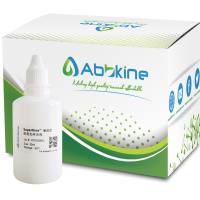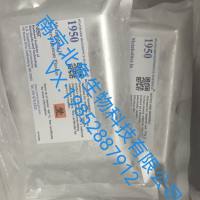Embedding, Sectioning, and Mounting of Frozen Tissues
互联网
Embedding, Sectioning, and Mounting of Frozen Tissues
Chen-Ming Fan Lab,Carnegie Institute of Washington
Embedding of Frozen Tissues.
Let PFA fixed embryos sink to the bottom of a tube containing a 30% sucrose (in
PBS) solution overnight. After they have sunk, remove all but 2-3 mL's of the
solution. Add an equal volume of O.C.T. to the tube, and place it on a gentle
rocker for 1-2 hours to allow the embryos to equilibrate to the new solution. Get
an appropriate number of embedding wells, and fill them to the line with O.C.T..
Pipet in the desired number of embryos, minimizing the amount of
sucrose/O.C.T. solution transfered, as pockets of sucrose solution may cause
sectioning inconsistancies. Also, try not to create bubbles. Assemble and
position the embryos as desired at the bottom center of the well. Once the
embryos are positioned, quickly place the well in dry ice, making sure it is as
level and upright as possible to minimize the possibility of the embryos shifting
their position. Once they are frozen, place them in a pre-chilled Freeze-It
container, and store them at -80°C until you are ready to section.
Sectioning with the Leica Cryostat.
The Cryostat is normally always on, but in sleep mode when not in use. Hold
down the button until the green display backlight comes on. Press the
light bulb button to turn on the cryostat's interior lights. Locate the sample
mount (shaped like a large metal thumbtack with machined concentric circles in
the top), and squirt a small dollop of OCT on the top surface. Break off the
plastic well mold from your sample to be sectioned, and stick your sample to the
sample mount. Place the mounted sample upright in the slot in the lower left
inside the cryostat so that the OCT used to stick the sample to the mount freezes.
When it has frozen, slide the protruding end of the sample mount into the slot
on the moving head of the cryostat, and fix it in place by tightening down the
knobs sticking out of the top and right side. Adjust the position of the sample's
sectioning face so that it is parallel to the blade in both the X and Y planes. The
hand wheel on the right side of the cryostat is used to move the sample up and
down. The face of the sample is likely quite far (several mm's) from the blade.
To rapidly advance the sample surface to the blade, adjust the Trim dial to 100 or
150 microns, and press the trim button once (both controls located on the left
center panel). A green light within the Trim button should illuminate. At this
point you can manually turn the handwheel (clockwise, or away from you) until
the sample surface appears to almost contact the blade. At this point, press the
Trim button again to turn the feature off, and set the working section thickness
with the hand dial located inside the refrigerated part of the cryostat, to the right
of the sectioning head. 12-20 microns is typical. Now set the "cutting window",
which identifies the top and bottom of the sample. Press the one stroke button,
, once. Turn the handwheel until the sectioning head is on a downstroke,
and "[ ]" is displayed on the screen. Continue to turn the handwheel slowly until
the bottom of the sample is just in line with the blade. Press the button
once to set the start of the cutting window. Continue to turn the handwheel
until the top of the sample just disappears behind the blade, and push the same
button once again to set the end of the cutting window. If you have done this
correctly, when you push both run buttons at once, the machine should
automatically go fast above and below the area you have indicated, but go very
slowly through the sample, producing an even section. Flip down the clear
plastic section guide to collect the sections most evenly. Ideally, the section
should be slightly attached to the blade so that it doesn't curl up from both ends,
enough that you can unroll the unattached portion of the section gently with a
brush.
Once sections are being shaved off satisfactorily, they must be collected on
a Superfrost Plus slide. Collect the sections on the label side of the slide, usually 8
sections to a slide. One embryo thickness of sections can produce 15-30 slides.
The slides should be kept in a sealed slide box at 4°C until they can be rehydrated
and mounted.
Rehydrating and Mounting Slides.
Care must be taken to avoid losing or damaging the tissue sections during the
mounting process. The slides should be rehydrated in 1xPBS in small batches
(alternating batches of 5 works well), so that the sections are not soaking too
long, which can cause them to lift up when the coverslip is being placed. Ideally,
most of the O.C.T. should have dissolved, but the section should still be firmly
attached to the slide. Roughly 10 minutes rehydrating time usually works well.
After rehydrating the slide, remove it from the slide holder, and blot the edges
on a paper towel, removing most of the liquid, but leaving enough that the
tissue-side of the slide is still visibly wet. Lay the slide flat on the paper towel,
and apply two drops of Crystal/Mount to the face of the slide opposite the labelside.
apply 2 drops here Immediately apply the 24x60 mm coverslip, left
edge first, so that the liquid/air line travels toward the right, leaving no bubbles
behind. Do not move the coverslip once it has been applied, because you may
disturb the sections and distort their morphology. Blot the edges of slide again
to absorb any excess liquid squeezed out during the application of the coverslip.
Let the slide sit for about 1 hour, or until the Crystal/Mount has hardened. Seal
the seam between the coverslip and the slide with nail polish to ensure that the
sections will not dry out.
上一篇:鼠尾制备胶原蛋白-Making collagen solution from lyophilized rat tail collagen 下一篇:Genotyping from mouse tails









